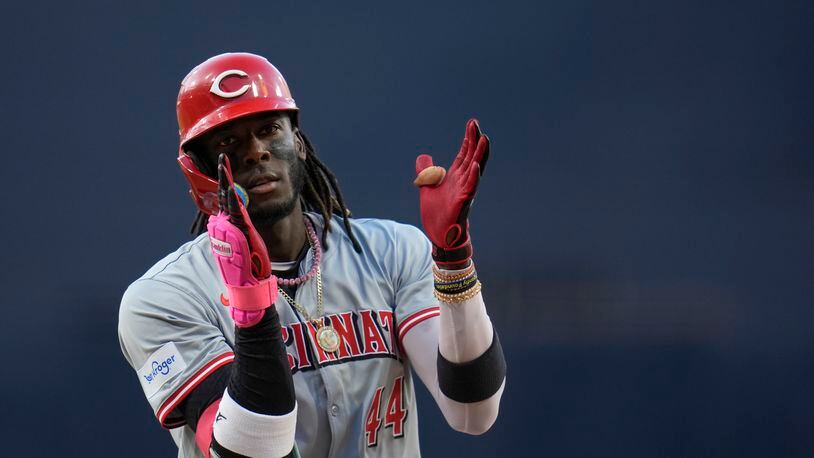A: Absolutely. Some Latinos play their entire MLB careers without expressing themselves in English. But there are also some American-born players who, judging by their syntax, flunked English in high school. In Elly’s case, I commend him more for what he did in the off-season baseball-wise. Mostly, he has learned the strike zone and no longer can be baited into swinging at pitches outside the stadium’s zip code.
Q: Do you think the Cincinnati Reds are a playoff contender? — ERIC, Lima
A: Indeed. In one year, they have gone from pretender to contender. It helps that they are in a watered-down division, but that’s not their fault. They are off to a good start despite missing three key parts — T.J. Friedl, Matt McLain and Noelvi Marte. All the young pitchers, after a dose of the big-league environment last season, seem to have absorbed what it takes to win and that includes Hunter Greene, Nick Lodolo, Andrew Abbott and Graham Ashcraft. The key? Stay away from injuries. . .and that’s a difficult thing to do, especially pitchers.
Q: An NFL game has about 12 ½ minutes of actual playing time in a 60-minute gam, so what is the comparable amount of action time during an MLB game? — DICK, Washington Twp.
A: Baseball trumps football. One study of several MLB games revealed that during a nine-inning game that lasts three hours, there was actual action for 17 minutes and 58 seconds. The rest of the time players adjusted their batting helmets and batting gloves or glowered at umpires. Hey, it could be worse. Cricket matches last five days with about 20 seconds of so-called action.
Q: Catchers and pitchers are wearing PitchCom devices to relay signals, so how many other players can wear them and how about coaches? — BILL, Villa Hills, KY.
A: Many shortstops and second basemen also wear the receivers so they know what pitch will be delivered and they can shade defensively one way or another. MLB permits two transmitters (catcher and pitcher) and five receiving devices to be used at once. A receiver has not reached the press box yet, but I’d love to know in advance what pitch is coming, although I don’t know what the heck I’d do with that information.
Q: An umpire got hit in the hand by a foul ball recently, so why aren’t they taught to put their arms behind their backs? — GREG, Beavercreek.
A: I’m not privy to what they teach at umpire school, but it seems each one has his own style. Most do keep their hands behind their back when a pitch is on its way. Some like to use one hand to rest on the catcher’s shoulder to steady their balance. That seems distracting to me, and I’d slap that hand away, except I’d probably never get a border-line call for my pitcher.
Q: Can you explain the logic of a batter getting to run to first base if the catcher drops the third strike? — MIKE, Indianapolis.
A: No, I can’t. There is no logic. I never understood why a batter who strikes out gets a chance to reach first base. Makes zero sense. So what if the catcher doesn’t catch the ball? If that’s the rule, why not go all the way and permit the batter to run to first base if the catcher misses strike one or strike two when the batter swings and misses. To me it is an archaic, non-sensical rule that should be dismissed. It is bad enough that commissioner Rob Manfred puts the free runner on second base to start extra innings.
Q: Is it true that a Hall of Famer once pitched a 14-inning complete game in the World Series? — DICK, Hendersonville, TN.
A: Ah, a trick question, but I know the answer. He is in the Hall of Fame, but not as a pitcher. His name is George Herman ‘Babe’ Ruth. He was a pitcher in the 1916 World Series for the Boston Red Sox. Ruth pitched Game 1 — 14 innings in a 2-1 Red Sox win over the Brooklyn Robins. He gave up six hits and one run was a home run. And, of course, Ruth drove in one of the two runs. I just missed getting to interview him.
Q: Do you think it is a good thing they put so many pitch limits on starting pitchers these days? — SHAUN, Englewood.
A: As everybody knows, when it comes to baseball, I’m old school, one-room schoolhouse. And I believe pitchers are babied these days. But bouncing to the other side, pitchers today throw much harder, especially on breaking pitches on which they use heavy torque. And most managers believe that twice through a batting order is enough and that the third time through is a danger zone for a tiring starter. But nobody asked Bob Gibson, Warren Spahn, Juan Marichal, Nolan Ryan or Randy Johnson if they subscribed to it.
Q: Tell me a good John Franco story? WILL, Edgewood.
A: I never comprehended why the Reds traded Franco to the New York Mets after the 1989 season. In six years as the team’s closer he saved 148 games. He was traded to the New York Mets after the 1989 season and saved 276 games for them. The Reds received Randy Myers in the deal, and he was part of the 1990 Nasty Boys (Myers, Rob Dibble, Norm Charlton) and saved 31 games. Then nothing. He was a part-time starter in 1991 and was 6-13 with six saves. After two years with the Reds, he was gone, traded to the San Diego Padres for Bip Roberts. Franco still holds the National League record for most pitching appearances in a career, 1,119. He belongs in the National Baseball Hall of Fame, but for some strange reason he isn’t even in the Reds Hall of Fame, although relief pitchers Clay Carroll, Pedro Borbon and Danny Graves are.
About the Author
